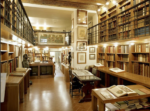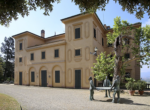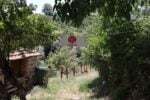Frank Gehry – Fish Lamps
.jpg)
Gagosian Gallery è lieta di presentare “Frank Gehry: Fish Lamps”, un’installazione di dinamiche sculture luminose.
Comunicato stampa
Scroll down for Italian version / Testo in italiano al termine della versione in inglese]
The fish is a perfect form.
--Frank Gehry
Gagosian Gallery is pleased to present "Frank Gehry: Fish Lamps," an exhibition of Gehry's animated and dynamic light sculptures.
One of the most celebrated architects living today, Gehry's career spans six decades and three continents. Known for his imaginative designs and creative use of materials, he has forever altered the urban landscape with spectacular buildings that are conceived as dynamic structures rather than static vessels.
Gehry has always experimented with sculpture and furniture in addition to his architectural pursuits, coaxing inventive forms out of unexpected materials, from the Easy Edges (1969-73) and Experimental Edges (1979-82)--chairs and tables carved from blocks of industrial corrugated cardboard--to the Knoll furniture series (1989-92), fashioned from bentwood. The Fish Lamps evolved from a 1983 commission by the Formica Corporation to create objects from the then-new plastic laminate ColorCore. After accidentally shattering a piece of it while working, Gehry was inspired by the shards, which reminded him of fish scales. The first Fish Lamps, which were shown in "Frank Gehry: Unique Lamps" in 1984 at Gagosian Los Angeles, employed wire armatures molded into fish shapes, onto which shards of ColorCore are individually glued, creating clear allusions to the morphic attributes of real fish.
Since the creation of the first lamp in 1984, Gehry's Fish Lamps have been exhibited in London, Paris, Hong Kong, and now Rome. The fish has become a recurrent motif in Gehry's work, as much for its "good design" as for its iconographical and natural attributes. Its quicksilver appeal informs the undulating, curvilinear forms of the Guggenheim Museum in Bilbao, Spain (1997); the Jay Pritzker Pavilion in Chicago (2004); and the Marqués de Riscal Vineyard Hotel in Elciego, Spain (2006), as well as the Fish Sculpture at Vila Olímpica in Barcelona (1989-92) and Standing Glass Fish for the Minneapolis Sculpture Garden (1986).
In 2012 Gehry decided to revisit his earlier ideas, and began working on an entirely new group of Fish Lamps. The resulting works range in scale from life-size to outsize, and the use of ColorCore is bolder, incorporating larger and morejagged elements. The sculptures are each unique, and each made by hand.
The softly glowing Fish Lamps are full of whimsy and vigor. Curling and flexing in attitudes of simulated motion, these artificial creatures emit a warm, incandescent light. This intimation of life, underscored by the almost organic textures of the nuanced surfaces, presents a spirited symbiosis of material, form, and function.
Frank Gehry was born in Toronto in 1929. He studied architecture at the University of Southern California and urban planning at the Harvard Graduate School of Design. His drawings, models, designs, and sculpture have been exhibited in major museums throughout the world. Among his most celebrated buildings are the Vitra Design Museum, Weil am Rhein, Germany (1989); the Guggenheim Museum, Bilbao, Spain (1997); and the Walt Disney Concert Hall, Los Angeles (2003). Awards include the Pritzker Architecture Prize (1989); the Wolf Foundation Prize in Arts (1992); the Praemium Imperiale in Architecture from Japan Art Association (1992); the Dorothy and Lillian Gish Prize (1994); the National Medal of Arts (1998); the Gold Medal from the American Institute of Architects (1999); the Gold Medal from the Royal Institute of British Architects (2000); and the Lifetime Achievement Award from Americans for the Arts (2000).
Solo museum exhibitions include "Frank Gehry, Architect," Solomon R. Guggenheim Museum, New York (2001); Centre Pompidou, Paris (2014); Los Angeles County Museum of Art, Los Angeles (2015). Gehry's latest buildings include the Louis Vuitton Foundation for Creation in the Bois du Boulogne, Paris (2014); the Dr Chau Chak Wing Building at the University of Technology, Sydney (2014); and the new Facebook building in Menlo Park, California (2015).
Gehry lives and works in Los Angeles.
For further inquiries please contact the gallery at +39.06.4208.6498 or at [email protected]. All images are subject to copyright. Gallery approval must be granted prior to reproduction.
Please join the conversation with Gagosian Gallery via the hashtags #FrankGehry #FishLamps #GagosianRome.
__________
Frank Gehry
Fish Lamps
July 18 - September 16, 2016, 2016
Gagosian Gallery
Via Francesco Crispi 16
00187 Rome
www.gagosian.com
__________
Il pesce è una forma perfetta.
--Frank Gerhy
Gagosian Gallery è lieta di presentare "Frank Gehry: Fish Lamps", un'installazione di
dinamiche sculture luminose.
Tra i più famosi architetti contemporanei, Frank Gehry vanta una carriera internazionale lunga sessant'anni. Noto per i suoi progetti geniali e l'uso creativo dei materiali, ha mutato per sempre il panorama urbano attraverso edifici spettacolari concepiti come strutture attive piuttosto che come contenitori statici.
Gehry ha sempre sperimentato nell'ambito della scultura e dell'arredamento parallelamente alle sue ricerche architettoniche, estrapolando forme originali da materiali inusuali: da Easy Edges (1969-73) ed Experimental Edges (1979-82)--sedie e tavoli intagliati da blocchi di cartone ondulato--alla serie di mobili Knoll (1989-92), in legno sagomato. Le Fish Lamps nascono nel 1983 da una commissione della Formica Corporation per la creazione di oggetti nell'allora innovativo laminato plastico ColorCore. Dopo aver accidentalmente frantumato una lampada sulla quale stava lavorando, Gehry trasse ispirazione dalle schegge, che gli ricordavano le scaglie di pesce. Per la prime Fish Lamps, esposte nel 1984 a Los Angeles in "Frank Gehry: Unique Lamps", Gehry costruì delle armature in fil di ferro modellate in forma di pesce, sulle quali poi incollava singolarmente dei frammenti di ColorCore creando evidenti richiami alle caratteristiche morfiche degli animali reali.
Dalla creazione della prima lampada nel 1984, le Fish Lamps sono state in mostra a Londra, Parigi, Hong Kong e ora a Roma. Il pesce è diventato un motivo ricorrente nel lavoro di Gehry, tanto per il suo "buon design" quanto per le sue caratteristiche naturali e iconografiche: il suo fascino imprevedibile contraddistingue le forme ondulate e curvilinee del museo Guggehheim a Bilbao, Spagna (1997); il Jay Pritzker Pavilion a Chicago (2004); e l'hotel Marqués de Riscal Vineyard a Elciego, Spagna (2006), così come la Fish Sculpture alla Vila Olímpica a Barcellona (1989-92) e lo Standing Glass Fish per il Minneapolis Sculpture Garden (1986).
Nel 2012 Gehry rivisita la sua idea originaria iniziando a lavorare su un gruppo completamente nuovo di Fish Lamps, a grandezza naturale e fuori misura, impiegando in maniera più ardita il ColorCore e inserendo forme sempre più grandi e frastagliate. Ogni scultura è unica e fatta a mano.
Con il loro bagliore leggero le Fish Lamps esprimono l'originalità e il vigore dell'artista: curve e flesse nella simulazione del movimento, queste creature artificiali emettono una luce calda e incandescente. Tale omaggio alla vita, sottolineato dalla consistenza quasi organica delle superfici sfumate, rappresenta una sinergia dinamica di materiale, forma e funzione.
Frank Gehry è nato a Toronto nel 1929. Ha studiato architettura alla University of Southern California e pianificazione urbana alla Harvard Graduate School of Design. I suoi disegni, modelli, progetti e sculture sono stati esposti nei più importanti musei del mondo. Tra i suoi più famosi edifici si annoverano il Vitra Design Museum, Weil am Rhein, Germania (1989); il Guggenheim Museum, Bilbao, Spagna (1997); e la Walt Disney Concert Hall, Los Angeles (2003). Tra i premi ricevuti: il Pritzker Architecture Prize (1989); il Wolf Foundation Prize in Arts (1992); il Praemium Imperiale in Architecture dalla Japan Art Association (1992); il Dorothy and Lillian Gish Prize (1994); il National Medal of Arts (1998); il Gold Medal dall'American Institute of Architects (1999); il Gold Medal dal Royal Institute of British Architects (2000); e il Lifetime Achievement Award dall'Americans for the Arts (2000).
Mostre personali museali includono: "Frank Gehry, Architect", Solomon R. Guggenheim Museum, New York (2001); Centre Pompidou, Parigi (2014); Los Angeles County Museum of Art, Los Angeles (2015). Tra i suoi più recenti edifici si annoverano: la Louis Vuitton Foundation for Creation nel Bois du Boulogne, Parigi (2014); il Dr Chau Chak Wing Building alla University of Technology, Sidney (2014); e il nuovo edificio Facebook a Menlo Park, California (2015).
Gehry vive e lavora a Los Angeles.
Per qualsiasi informazione si prega di contattare la galleria a +39.06.4208.6498 o a [email protected]. Tutte le immagini sono coperte da copyright. L'approvazione della galleria deve essere concessa prima della riproduzione.
Si prega di partecipare alla conversazione con Gagosian Gallery tramite gli hashtags #Frank Gehry #FishLamps #GagosianRome.



